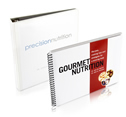Earlier this week, we had 7 incredible Hockey Nutrition Tips from Brian St. Pierre. If you missed them, check them out below:
With the off-season upon most of the hockey world, I’m getting a lot of questions from players about how to add muscle mass. A few others want to shed some fat this off-season. I’m glad I’m getting the questions. The off-season is really the time where hockey players can make HUGE changes to their bodies and nutrition is a big part of that.
With that in mind, I want to introduce the best sports nutrition resource out there. Now, I’ll preface this by saying that Brian and I have plans to write a Hockey Nutrition Manual sometime in the near future. Unfortunately, the project keeps getting pushed back because Brian has “more important things” to do like “getting married” and “taking care of his new puppy” (which did a depth jump off a couch and broke it’s leg in the first week they owned it…the puppy was quick to learn Brian’s high intensity training mentality, picture below).

We WILL finish the Hockey Nutrition Manual before 2010 ends. In the meantime, there is an absolutely amazing nutrition resource that I think every coach, parent, player, and water bottle should own: Dr. John Berardi’s Precision Nutrition!
I’m still blown away that there are people out there that don’t own this. It’s the single best nutrition resource ever. It amazes me that people hesitate to spend money on this, but they’ll gladly spend hundreds of dollars on supplements. Precision Nutrition isn’t a weight loss guide. It’s not a muscle gaining guide. It’s a SYSTEM that teaches you how to manipulate your diet to achieve ALL of your health, performance, and body composition goals. If you need to gain muscle mass this year, Precision Nutrition will help. If in a couple years you need to shed some fat, Precision Nutrition will help.
The PN System includes: The Success Guide, The Diet Guide, The Quick Start Guide, The Super Shake Guide, 5-Minute Meals, The Individualization Guide, The Measurement Guide, The Plant-Based Diet Guide, The Maintenance Guide, and The Support Guide. It also comes with Gourmet Nutrition, my favorite cookbook!
Check out Dr. Berardi’s Precision Nutrition “Executive Summary”:
- Covers everything you need to know about nutrition. Precision Nutrition contains everything you need to get the body you want.
- Teaches you how to eat for your goal and your body. We teach you how to develop a custom nutrition plan unique to your physiology.
- Written in plain English. We make advanced nutrition research easy to understand – and easy to use, right away.
- 1 year of 24/7 online support on our private member forum. You’ll need help, and with PN you get it – from our expert coaches and nearly 40,000 fellow members from around the world.
- 1 year membership to our online library of articles, e-books and software. Access our complete Exercise Video Database and thousands of pages covering every conceivable fitness and nutrition topic in the Member Zone.
- Includes more than 25 goal-specific exercise programs by world-class coaches. We had the top coaches in the world develop exercise programs specifically for Precision Nutrition members.
- Includes the PN cookbook, Gourmet Nutrition Volume 1. Good, healthy food can be delicious, and in Gourmet Nutrition we show you how.
- Results 100% guaranteed. We put our money where our mouth is. If PN doesn’t work for you, we’ll not only give your money back, we’ll buy you another book of your choosing!
- $50 off before April 15th! Order today for an unbeatable deal.
If you have questions about this system, please do not hesitate to contact me. This is the exact nutrition system that many of the top strength and conditioning professionals in North America use, and I know hockey players up through the pro levels that use it as well.
Make the smartest investment of your life and check out Precision Nutrition now!
To your off-season success,
Kevin Neeld




 Use CODE: "Neeld15" to save 15%
Use CODE: "Neeld15" to save 15%